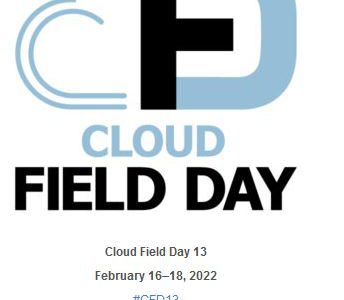I was invited to participate as a delegate for Cloud Field Day 13 from Feb. 16 – 18, 2022 in San Jose, CA. Check out my day one recap if you missed it earlier. Day two consisted of presentations from VMware and Metallic.
VMware
VMware spent the first half of the day focused on their portfolio of multi-cloud capabilities. During the presentation, VMware defined “A Multi-Cloud strategy provides organizations with the ability to securely run workloads in any cloud provider of their choice, including on-premises and at the edge, with a single operational model.”
I have worked with VMware to build both private clouds as well as software defined data centers (SDDC) within AWS. While it is impossible to provide the exact same experience for every possible way of deploying VMware Cloud Foundation, the management and operational models are evolving to converge towards one consistent platform across all clouds.
VMware presented this vision in a number of different ways at CFD13. We started with their overall vision, and then moved into a focus on VMware Tanzu and the developer experience. We also got to see a demo of the Tanzu Application Platform in action.
After Tanzu, VMware jumped into Cloud Health and how it integrates with the portfolio for FinOps and Security. These topics play well in the day two management aspect of cloud, but also seemed out of place in the overall flow of this series of presentations. That is because VMware wrapped up, albeit rather quickly due to time constraints, with connecting and protecting modern apps across clouds. This topic is key to the overall multi-cloud conversation, and certainly tends to be overlooked when the focus seems to be optimization within a specific cloud. The delegates would have loved to dive deeper with this, and hopefully that can happen at another field day event.
As we have seen play out both at CFD13 and in current cloud trends, there are still a lot of traditional silos that are being broken by technological advancement. There doesn’t seem to be an industry trend headed towards one platform being the “best of breed” when it comes to cloud. Rather, organizations are kind of on their own to do things in a way that suits them (and their workloads) best. Much of the Tanzu demo was similar to other demos we saw during CFD13 by switching over to VScode and github:

All Twitter snark aside, one consistent cloud platform can mean something very different depending on your role. Getting to the point where developers don’t really care what it is running their apps takes a ton of buy in from many parts of an organization. Will we ever reach a point where the standard for modern apps is just creating a namespace within vCenter? It is hard to tell, but VMware is pushing towards that goal.
VMware: VMware Cross-Cloud Services: From Dev to Ops
VMware: Deliver a Superior Developer Experience on Kubernetes with VMware Tanzu Application Platform
Metallic
Metallic is a Commvault Venture, so we knew that cloud data protection would be the focus of their presentation. I will admit that I am not very familiar with Commvault from my on-prem focused days. Many people may empathize with my situation in that a different region for a previous employer of mine had a Commvault relationship, whereas my region focused on a different vendor. That meant knowledge silos depending which geography you covered.
Not knowing the inner workings of Commvault, I was interested to learn that they spun up Metallic to provide a Data Management as a Service (DMaaS) offering with a different name, but utilizing some of Commvault’s existing technology under the covers.
One interesting thing on the surface is that Metallic is powered my Microsoft Azure. It seems like AWS typically dominates the conversation for data management services running in the public cloud, but something like Active Directory can be an important enough factor to steer things towards Azure.
Aside from presenting the DMaaS platform itself, CFD13 saw use cases focused on ransomware, managing hybrid cloud data sprawl and driving SaaS app adoption. I’d argue that these specific use cases, primarily that of ransomware, are top of mind for most customers when considering next-gen data management solutions.
Metallic has FedRAMP high status and runs their service control plane in a “virtually air gapped” environment separate from the workloads they protect. Customers consume the service from the Metallic Hub, which gives access to all the different Metallic services available, as shown below in the demo presented during CFD13.
Overall there was consensus among the delegates that the Metallic gave one of the most well-rounded presentations we saw all week. The overview, demos and high value example topics made for a really good flow, even as we did our best to side track things with questions.
Metallic: Metallic Data Protection and Its Role in Ransomware Recovery + Demo
Disclaimer: I was invited by Gestalt IT to participate as a delegate for this Tech Field Day presentation. I was not obligated by anyone to post about any of the presentations that occurred during Tech Field Day. Any blog posts, tweets or other content related to my time at Tech Field Day are my own views for the sole purpose of creating content for virtualbonzo.com.




